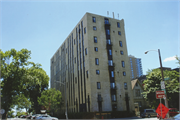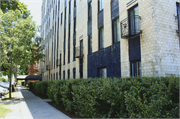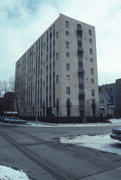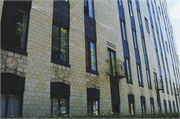Property Record
1705-1717 E KANE PLACE
Architecture and History Inventory
| Historic Name: | VIKING APARTMENTS |
|---|---|
| Other Name: | VIKING APARTMENTS |
| Contributing: | Yes |
| Reference Number: | 68762 |
| Location (Address): | 1705-1717 E KANE PLACE |
|---|---|
| County: | Milwaukee |
| City: | Milwaukee |
| Township/Village: | |
| Unincorporated Community: | |
| Town: | |
| Range: | |
| Direction: | |
| Section: | |
| Quarter Section: | |
| Quarter/Quarter Section: |
| Year Built: | 1931 |
|---|---|
| Additions: | |
| Survey Date: | 2004 |
| Historic Use: | apartment/condominium |
| Architectural Style: | Art Deco |
| Structural System: | |
| Wall Material: | Brick |
| Architect: | Martin Tullgren & Sons; Herbert W. Tullgren |
| Other Buildings On Site: | |
| Demolished?: | No |
| Demolished Date: |
| National/State Register Listing Name: | Prospect Avenue Apartment Buildings Historic District |
|---|---|
| National Register Listing Date: | 4/19/1990 |
| State Register Listing Date: | 1/23/1990 |
| National Register Multiple Property Name: |
| Additional Information: | A 'site file' exists for this property. It contains additional information such as correspondence, newspaper clippings, or historical information. It is a public record and may be viewed in person at the Wisconsin Historical Society, State Historic Preservation Office. Herbert Tullgren patented the two story duplex design used in this building. Herbert W. Tullgren patented this design layout U.S. Patent #1,896,734 (patented February 7, 1933). Photo code N stands for NPN. Excellent example of an innovative 1930s apartment building influenced by the Art Moderne style. This is a nine-story, rectangular building with primary buildings materials that include yellow tile brick, black terra cotta brick, black brick, and black vitrolite or structural glass. The narrow west elevation consists of large, central steel casement windows flanked by narrower steel casement windows; beginning with the third story, the outer windows on every alternate floor are square rather than rectangular in shape. The number of steel casement windows on the facade alternates from fifteen to twenty-one on alternate floors. Windows are grouped into vertical bands by the use of black terra cotta, black brick panels, and spandrels; the windows alternate with yellow brick pier for a striped effect. Virtually all horizontal elements such as belt courses, window surrounds, and cornices have been eliminated and the walls terminate abruptly in a parapet wall at the flat roof. Most of the first story windows are surmounted by black terra cotta panels above which are medallions featuring a Viking ship design. Every fourth window is joined to a second story window by spandrels of black brick. These second story windows feature curved wrought iron balconies and are accented with bands of black terra cotta. Within the apartments, hallways were virtually eliminated and the duplex arrangement required public corridors only on alternate floors. The Viking was the first duplex constructed in Milwaukee. Much of the design was standardized to allow the use of local materials and prefabrication. Previously surveyed in 1986 with map code 254/20. Map name was LUQS 355. |
|---|---|
| Bibliographic References: | PERMIT. The Architectural Record, v. 75, pp. 228-229, March 1934. Milwaukee Journal 2/23/1944. U.S. Patent #1,896,734 |
| Wisconsin Architecture and History Inventory, State Historic Preservation Office, Wisconsin Historical Society, Madison, Wisconsin |





